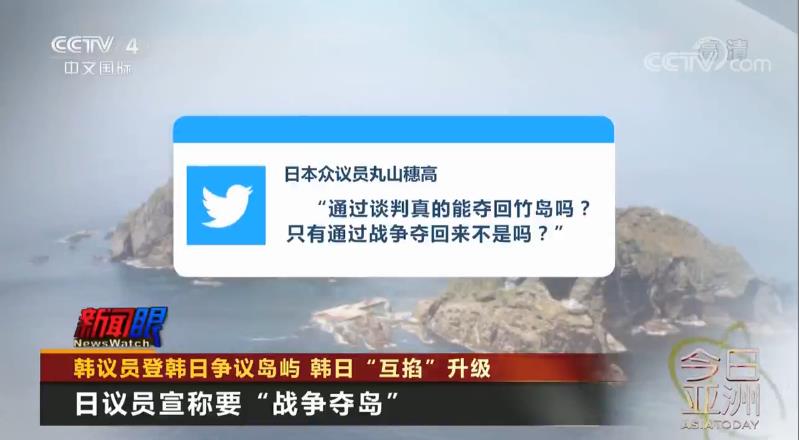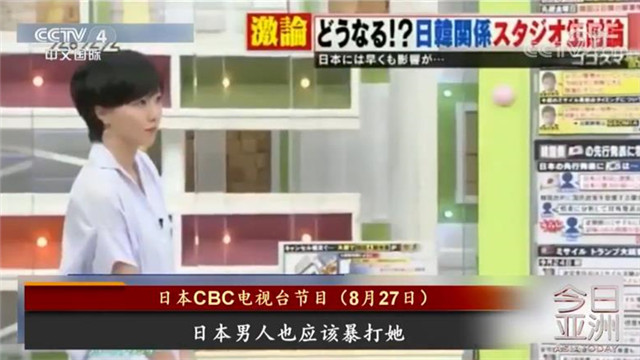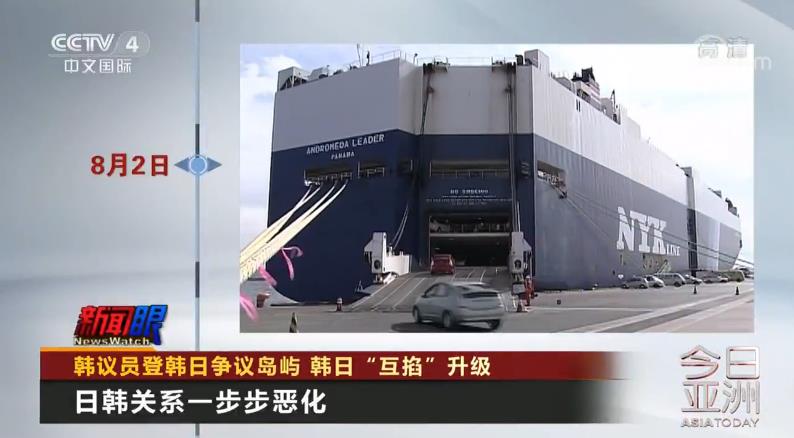Cctv newsThe dispute between Japan and South Korea has been escalating recently. On August 31st, South Korean parliamentarians "organized a group" to board Dokdo, a just island of Japan and South Korea, which triggered a strong protest from Japan, and Japanese parliamentarians even threatened to "seize the island through war".
Korean media: Senator Han "organized a group" to go to the island to protest Japan’s export control to South Korea.
According to Yonhap News Agency’s report, on August 31st, six members of parliament from the ruling and opposition parties of South Korea boarded the disputed island "Dokdo" between Japan and South Korea (called Zhudao in Japan) to inspect the South Korean garrison stationed on the island and the facilities on the island. Regarding the purpose of landing on the island, some members said that the move was a protest against Japan’s strengthening of export control to South Korea and asked the Japanese government to solve the labor problem in World War II.

Japanese Rep. Maruyama Suigao posted a message on Twitter.
Han Jun held the largest defense exercise in history on disputed islands in Japan and South Korea.
Dokdo, also known as "Bamboo Island" in Japan, is located in the eastern waters of the Korean Peninsula. All along, Japan and South Korea have claimed sovereignty over the island, which is actually controlled by South Korea. Japan’s Kyodo News reported that in the context of the trade dispute between Japan and South Korea, the confrontation between the two sides around the disputed islands is intensifying.
On August 25-26, the Korean army held the largest "Dokdo Defense Exercise" in its eastern waters. Yonhap News Agency quoted military sources as saying that this year’s participation in the military not only nearly doubled compared with previous years, but also dispatched the 7,600-ton Aegis destroyer "King Sejong" for the first time, demonstrating South Korea’s determination to defend the island in three dimensions by land, sea and air. In this regard, the Japanese side expressed great dissatisfaction.
Korean media: Han Jun’s rare exposure exercise screen "maximum pressure on Japan"
According to the report, since 1986, South Korea has held two defense exercises in Dokdo every year. Different from the low-key practice of Dokdo exercises in the past, this year, the Korean army rarely disclosed photos and video materials of the exercises, with the aim of "maximizing the pressure on Japan."
Japan marks disputed territory on Tokyo Olympic map, South Korea protests
In fact, it is not just the South Korean side that exacerbates contradictions. It is reported that in the torch relay road map published on the website of Tokyo Olympic Games, Japan marked Dokdo, a disputed island between Korea and Japan, as Japanese territory, which caused strong dissatisfaction between South Korea and North Korea.
At the same time, the civil confrontation between Japan and South Korea has also intensified.

According to South Korea’s MBC TV station reported on September 1st, Japan’s CBC radio station broadcasted a talk by a Japanese scholar in a recent program: This happened in an "anti-Japanese" atmosphere created by the (Korean) president and politicians. When a Korean woman comes to Japan, Japanese men should also beat her up.
Korean media said that this was a retaliatory remark against a Japanese woman who was attacked in South Korea. Previously, a video of Japanese women being subjected to violence in Korea was widely spread on the Internet in Japan and South Korea.
In the video, a Korean man accosted a Japanese woman. After being rejected, the man first insulted the woman, then grabbed the woman’s hair and pushed it to the ground. The Japanese people are worried that the violence may be related to the strong "anti-Japanese" sentiment in South Korea.
So how did Japan-ROK relations deteriorate step by step?
On July 4th, the Japanese government announced that it would strengthen control over three kinds of raw materials for semiconductor industry exported to South Korea. At that time, Japan said that the reason for taking control measures was that South Korea had problems in export management. The South Korean side accused that Japan’s move was "economic retaliation" for the South Korean Supreme Court’s decision to award Japanese companies compensation for forced labor.
On August 2, the Japanese government passed an amendment to the Regulations on Export Trade Management at the cabinet meeting, excluding South Korea from the "white list countries" enjoying preferential export management. The so-called "white list countries" are friendly countries recognized by Japan in terms of national security, and these countries are given preferential measures to simplify export procedures in exporting important strategic technologies and materials. In the afternoon, South Korean Deputy Prime Minister and Minister of Planning and Finance Hong Nanji responded, "We also took Japan from ‘ White list country ’ Eliminate it. "
On August 23, the South Korean government announced the abolition of the South Korea-Japan Military Intelligence Protection Agreement, and the dispute between Japan and South Korea escalated.

According to Yonhap News Agency, with the escalating dispute between Japan and South Korea, Lee Tae-ho, the second official of South Korea’s Foreign Ministry, met with Kenhe Suzuki, the Administrative Officer of Japan’s Foreign Minister, in Seoul on September 1st. Both sides still held their own positions on the current issues, but they believed that communication and coordination between diplomatic departments should be maintained in order to resolve the current dispute between South Korea and Japan and develop the relations between South Korea and Japan steadily.